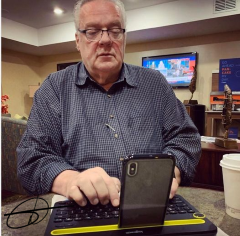We’ve all experienced poor communication. Something said, written, shared… and when you reflect over the words you realized the message is lost. Poor word choices, stated incorrectly, events out of order, even our emotional connection. You name it, nothing comes out the way we wished it had.
It’s almost like we’ve been switched from one line (style) to another line and the resulting communication makes absolutely no sense!
Mulling over some situations recently, I realized how poorly we communicate facts. They are often shaded with our version of the truth. We want to look righteous, even if we shuffle the events like a deck of cards.
Part of the problem comes from our emotional speak. We carry our emotions into our words. When they are spoken, you feel the emotions. When they are written, then others “read into” your words what “they” think you’re trying to say. Unless you are using emoticons!
Perhaps we should spend more time thinking about our position, and the best way to share what we feel we need to share! Equally, we must insure our lines of communication match the sender to the receiver.
How Can We Communicate Better?
I’m dealing with some business conversations, and when the other party starts to write out their expectations, then I reply the same way. It’s documented what each of us need to say.
What happens when we change to another form of communication? Easily, it’s like starting over! Why? The next form of communication changes the format of our words. There’s no history trail, and I must trust my memory, or note-taking ability. Or yours!
Now, change the communication from written and spoken, and enter the phase of face-to-face. It’s difficult to keep what was done from another path. We bring our body language to the table, thinking we are communicating better when we lean into the words, or sit back showing our non-acceptance. Folding our arms. Yawning. Take a sip of coffee. (There must be coffee available!)
Our form of communication takes on a new level! Now we have to read body language with words!
Perhaps the better way of communicating should revolve around the idea of choosing the best “form” that fits the need. What’s best for the moment? When I have something that requires clarity, and no emotional connection to the words, then utilizing written forms are perhaps the best. But when I need to “sell” my position, then I’m better off doing it face-to-face.
Here’s My Thought Today
The Apostle Paul was prolific in his writing, and traveling to far-flung destinations to plant the Gospel. In those ancient days of communicating, words were carefully chosen, along with tones, inflection, and style. Perhaps this is what’s missing today! Words come off as a threat when you really meant it as a compliment… Or vice versa. We’ve lost our ability to communicate clearly, or to receive with clarity.
In his early days of ministry, Paul dealt with issues that required face-to-face challenges of faulty writing and teaching. He was not shy about his position (read Acts 15). When the position was clarified it was communicated with a written letter (epistle) and voiced by those who had authority to speak the same words and sentiments of the letter.
In other words, the written word was verified with the spoken word.
We should choose the form of communication to the reason of our words. Emotional appeal works better in person, dispassionate facts are more easily communicated in writing. Click To TweetMaybe we should pause our multiple forms of communicating words, and spend some time rehearsing our position. In other words, quit opening mouth and inserting foot!
Think about it like this. When we do it in an anonymous way, as we often do in social construct, we say things we would never dream of saying in person.
Personal Communication
Think about saying what you mean, and meaning what you say. All the time!
“Then you should say what you mean,” the March Hare went on.
“I do,” Alice hastily replied; “at least–at least I mean what I say–that’s the same thing, you know.”
“Not the same thing a bit!” said the Hatter. “You might just as well say that “I see what I eat” is the same thing as “I eat what I see”!”
~Lewis Carroll
As I write my blogs, share on various social platforms, teach, and preach, I strive to have my words be equal everywhere. Sometimes, my emotions are checked at the door, and I become very dispassionate. Other times, I know where my words are going and feel very comfortable using my “feelings with my words”!
How about you? Do you have clarity of your position so that you can speak dispassionately? Maybe writing is good for you. But if you are struggling with keeping your emotions out of your words, then rehearsing your position via written pathways is wise.
Warning
Before you start a path of communication, you must consider the audience. When you want to “step on toes” then the audience has power to react however they choose. Are you willing to stand up to your communication regardless of who is listening?
This scripture came to mind yesterday, and I simply feel like we should keep our communication in mind as we decide how we are going to speak.

In this way you show respect for your God. I am the Lord.”
Leviticus 19:32 (GW)

